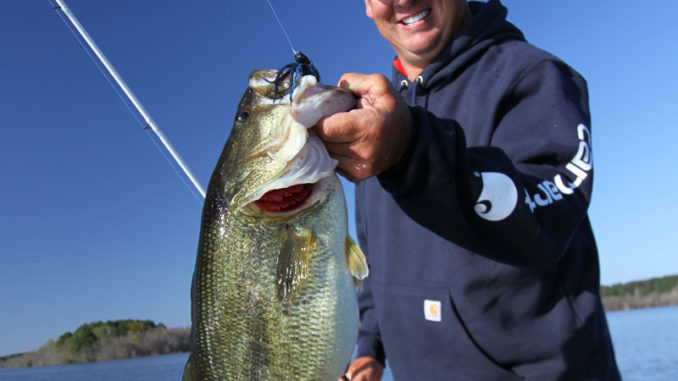
Different bass-fishing situations call for different kinds of fishing line. Know which ones fit where.
Monofilament, fluorocarbon and braided line — options are numerous, and while certain fundamentals definitely guide the decisions; there’s plenty of room for creativity and situation-specific uses. Maybe you’re trying to make a lure do something or not do something; perhaps, the habitat you’re fishing presents a concentrated set of considerations. In any case, understand that line choice can greatly impact your productivity.
Ingenuity shows no preference, and one trip to the pond could spawn a revolutionary thought. However, folks who fish for a living tend to come up with stuff that can help the rest of us; so let’s look at a handful of tips and strategies for line use from the best in bass fishing.
Where to fish it
One of the basic questions to ask is, “What do I want the bait to do?” Surface-oriented baits like walking topwaters and hollow-body frogs need the float of monofilament. You’ll also find that mono serves you well in open water with lures that sport treble hooks, as the stretch allows a fish to “get” the bait. For baits made to sink, dive or suspend in the water column, fluorocarbon is what you want.
When fishing around anything a bass can use to pull the old wrap-and-snap, you’ll usually appreciate the strength of braided line. There is, however, a drawback to this strategy, and FLW Tour pro Pete Ponds shares one of his insider tips to addresses a common vexation of topwater baits.
As Ponds points out, braided line floats, but as it lies limp on the surface, braid notoriously tangles front trebles or worse: the front blade of a prop bait like a Devil’s Horse. On the other hand, fluorocarbon’s sinking property often pulls down the nose of a topwater bait and mars the presentation.
Here’s how Ponds solves the problem: “A lot of time when I’m using braided line with a prop bait, I’ll tie a 3-inch leader of 25- to 30-pound monofilament leader. That keeps the braid from getting in the props,” he said.
“A lot of times, you’re in that thick stuff, and you need power to get power to get him out of the cover. If you’re using 30-pound (monofilament), you can’t make the cast. So you use 30-pound braid to be able to make the cast, while the monofilament leader keeps the braid from tangling in the prop.”
Notably, a fluorocarbon leader or main line may actually prove beneficial when you’re topwater fishing with poppers. Some anglers like to use exaggerated downward strokes, which force the bait below the surface. Doing so traps air for a maximum bubble trail, while the amplified “bloop, bloop, bloop” attracts aggressive fish.
Grass getters
Grass beds offer diverse opportunities through much of the year, but your line choice will definitely influence your effectiveness. Proximity is the biggest consideration, and while frogging atop thick mats clearly calls for braid’s zero-stretch and salad-cutting strength, other presentations raise different concerns.
“Whenever I’m fishing a lipless crankbait like a Cordell Spot over grass that’s, say, 4 to 5 feet deep on top, and you want a slow fall, I’ll use like a 25-pound Vicious monofilament as opposed to a smaller-diameter line,” Ponds said. “The bigger the diameter of your line, the slower the bait’s going to fall, especially when you’re using monofilament rather than fluorocarbon.”
Similarly, Bassmaster Elite Series pro Greg Vinson will use heavier fluorocarbon and a faster retrieve for thick, prespawn grass so his lipless bait doesn’t continuously bury in the vegetation. But with shorter, sparser grass, he can go with lighter line and a slow retrieve. The goal is to tick the tops of the grass, so adjusting line size helps achieve this.
Flipping legend Denny Brauer knows that fluorocarbon can keep him in the game when braid’s not happening. If you’re punching a weed mat and the fish are deep in the cover, braid’s you’re only hope for pulling them out of the thick stuff. However, if the fish are set up on the edges of the grass, braid may prove counterproductive to your efforts by standing out like a telephone line. In this case, Brauer will switch to fluorocarbon and pick up more bites on line that will still handle a thick habitat.
Sound matters, too, and Bassmaster Elite pro Gerald Swindle recalls a particular tournament when a good mat bite waned amid heavy fishing pressure. After the event, he found that he missed a key adjustment that delivered big results for some of his competitors.
“A couple of guys dropped down to 40-pound fluorocarbon and started flipping into these giant, gnarly grass mats where you’re thinking, ‘There’s no way you’re going to get a bass out of there.’
“But they were getting 10 bites to your one, so if they lost three, they still beat you. You might think there’s no way that bass can see the line in that thick mat, but I think more so they hear it sawing up and down on that grass. That’s what we call a ‘line-shy’ fishing situation.”
Here are a handful of additional pointers to aid in your line decisions:
Top shot: Tournament-level competition often sees anglers spooling spinning gear with 8- to 10-pound braid for drop-shotting and other stealth tactics. The benefits are high-sensitivity for the detection of subtle bites, a fast fall rate and fish-fighting strength in deeper scenarios.
Fluorocarbon leaders make this a best-of-both-worlds deal by adding the low-visibility to your line’s business end. Swindle has a good tip for this.
“I see guys using (shorter) leaders, but I’ll tie my braid to my leader, and I’ll reel until that knot is on the spool. Then, I’ll pull the leader all the way down the rod and cut it off. That’s about a 12-foot leader.
“First, you’re eliminating the risk that a fish can see anything. But a longer leader means if you break off, you can retie without having to redo your whole leader.”
Lighten up: Bassmaster Classic champion Casey Ashley may have a favored crankbait that runs 6 to 8 feet deep on 10-pound fluorocarbon, but conditions have the fish positioned in 3 feet of water. No worries; he doesn’t necessarily have to put down a bait in which he has confidence, he just changes how deep it will run.
“In this situation, you’d upsize to 15- or 17-pound line and switch to monofilament,” Ashley said. “Because monofilament floats, it’s going to hold your bait up a little higher, plus, you’re going with bigger line, and that’s going to help hold up the bait.”
Another “light-and-bright” tip comes from 2013 Bassmaster Classic champ Cliff Pace, who likes to crank to find prespawn fish. As bass move up each spring, they’re still shaking off winter’s chill. The fish are pushing past lethargy, but most are running about half speed, at best.
This allows Pace to downsize his line for the longer casts that allow him to cover more water. Dropping down to 10- or even 8-pound fluorocarbon may not be wise later in the year, but sluggish prespawners don’t fight very hard, so you can handle most fish on the lighter line.
Swindle takes the cold-water cranking strategy a step farther by switching to lighter mono. Greater stretch is more forgiving and allows the fish to get the bait better. As Swindle notes, fluorocarbon’s higher sensitivity often prompts overreaction.
“Sometimes, when you first feel the strike and you start reeling into him, the fish has not quite got the bait,” he said. “Also, in cold-water cranking, I can’t feel as good. My hands are cold, so with monofilament, if I’m running into structure, my bait doesn’t hang as often. Even if I’m not on my game, that monofilament is more forgiving.”
What “wood” you do? Bassmaster Elite pro Terry Scroggins is no stranger to braid, but when he’s flipping shallow cover, he knows that the line’s small diameter can become a liability.
“When you’re fishing around flooded trees or wood, you want to use heavy fluorocarbon, rather than braid, because braid will pinch down into the wood, and you’ll get hung up,” he said.
Color coded: Ashley said his monofilament color choice is either clear or moss green. The latter is his strong preference; Ashley said it will outfish even clear line 2-to-1.
Other color-related points:
• Camo. Various brands offer lines with alternating colors that break up their visibility underwater, but Spiderwire took a different approach with its Stealth Blue Camo Braid, introduced at ICAST 2015. Mimicking sky and clouds, this line offers an advantage for shallow water fishing on bright days.
• Hide it. Because the material used to create braided line won’t hold color very long, the section that’s getting repetitive use tends to fade to a lighter hue, if not white. That is a bona fide fish spooker, so Bassmaster pro Gary Klein uses a wide-tip permanent marker to color that section black. Cutting a slit in the tip promotes efficiency, as it keeps the like from slipping, while hitting all sides at once.
• Spot it. Conversely, the marking terminal end of your line with alternating stripes ensures you don’t lose track of it on a dim day. That’s a key benefit for distant or deep bed fishing when you have to notice small ticks in the line to detect light bites.
There are days when catching a fish requires little more than hitting the water. For all the others, know your line and make the choice that suits your objective.

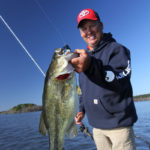
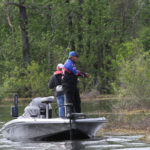
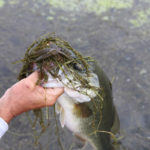
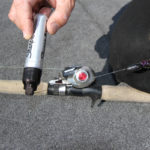


Be the first to comment